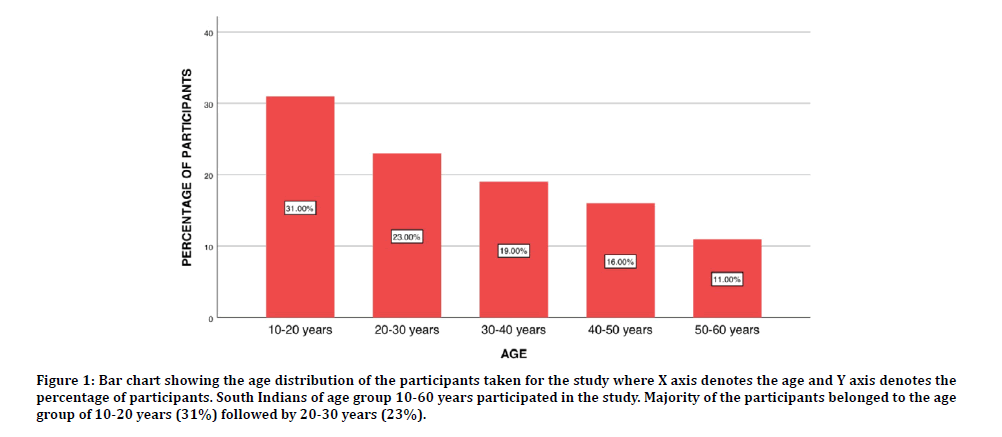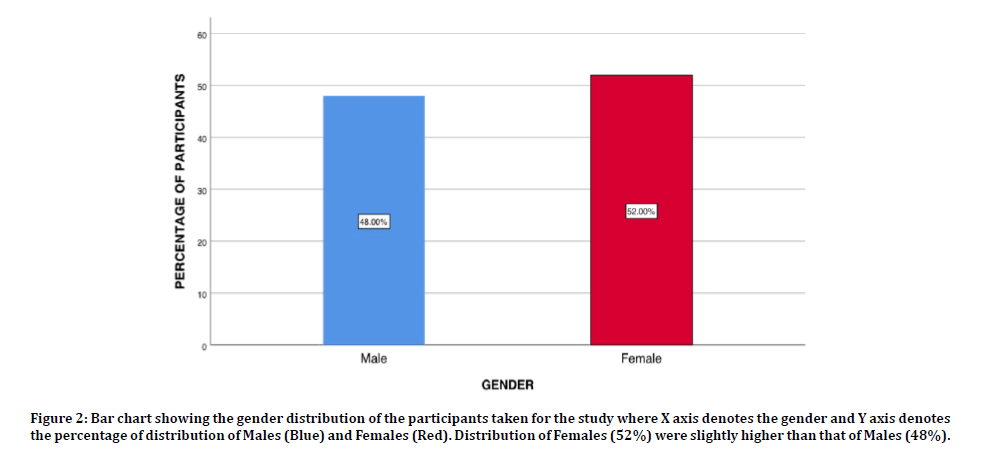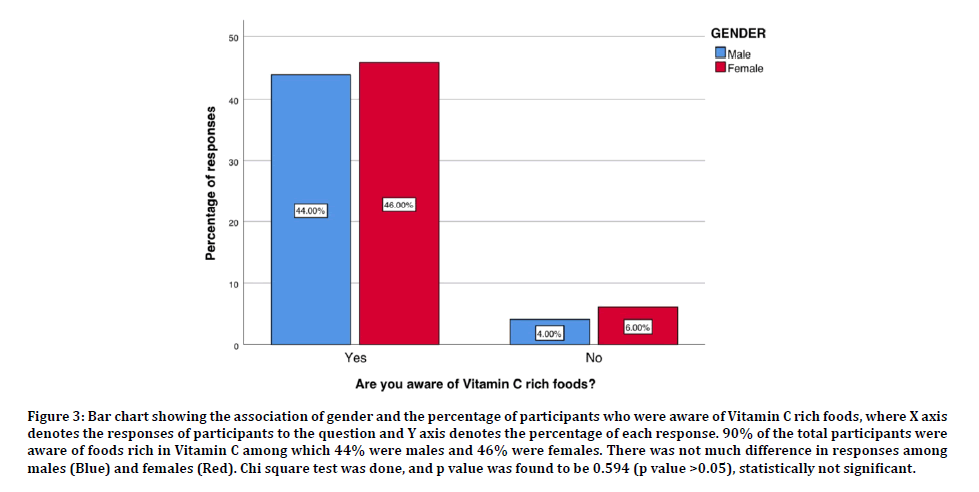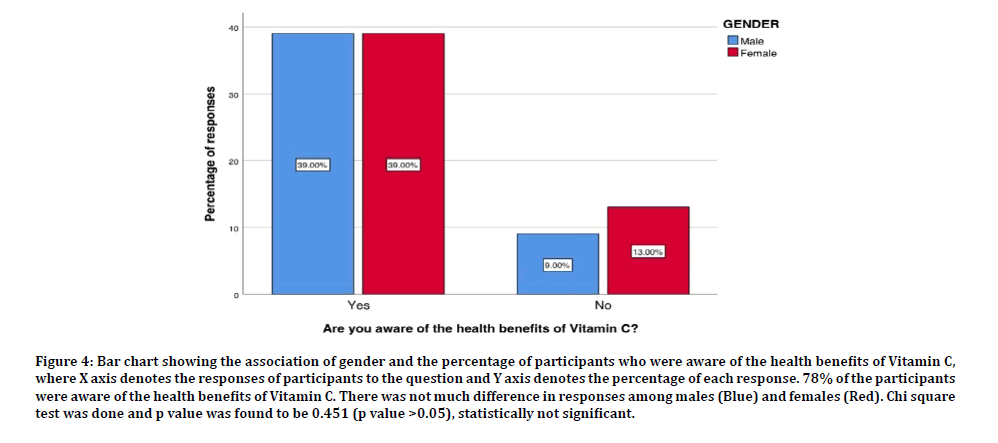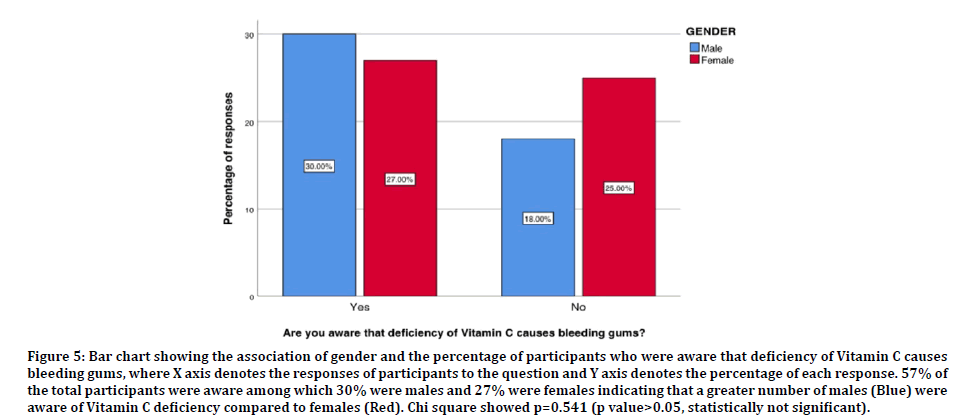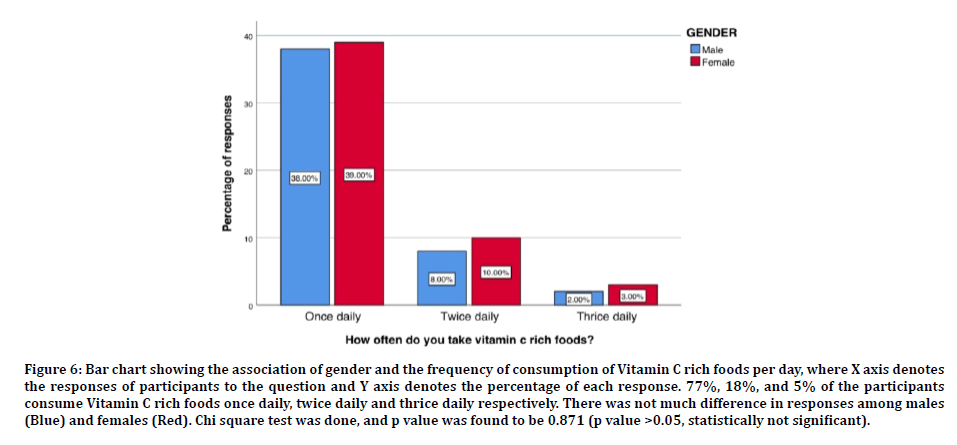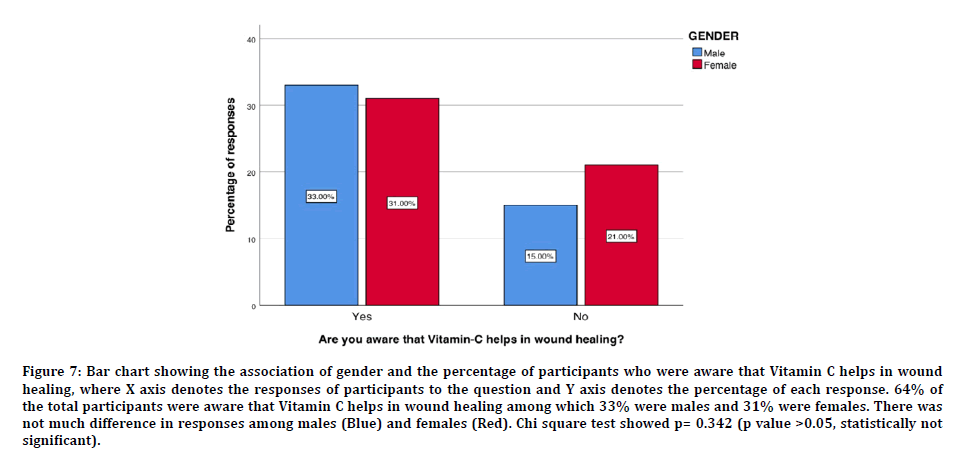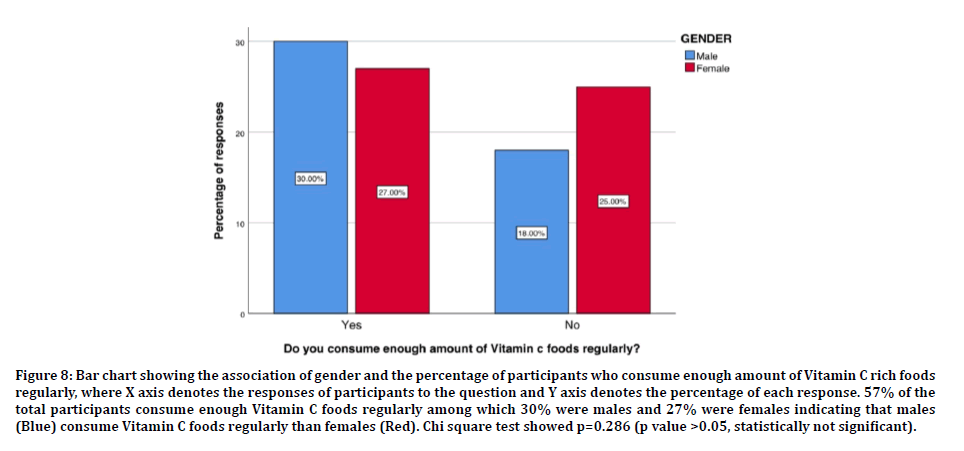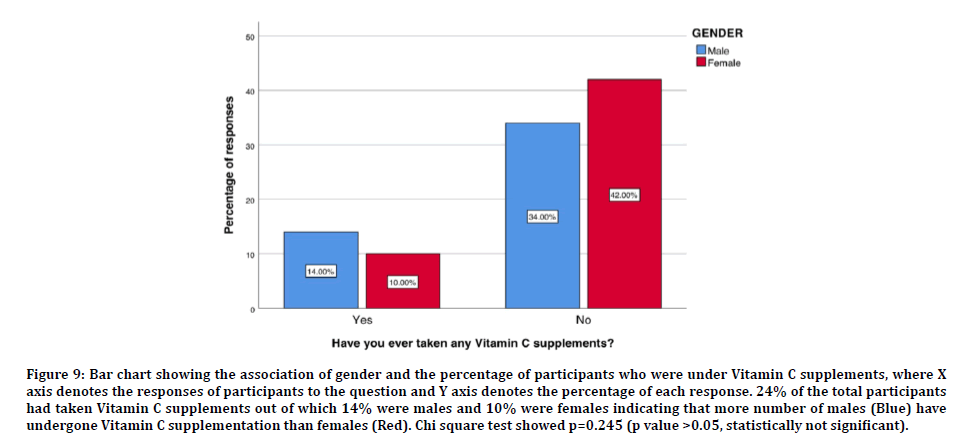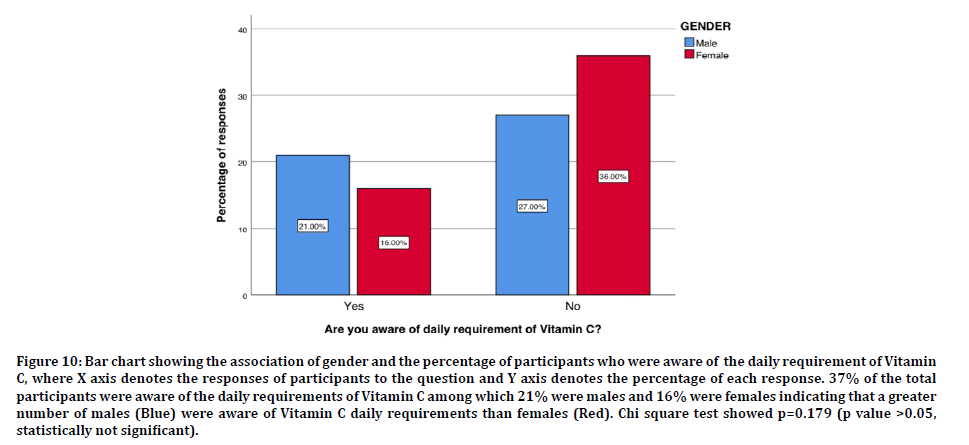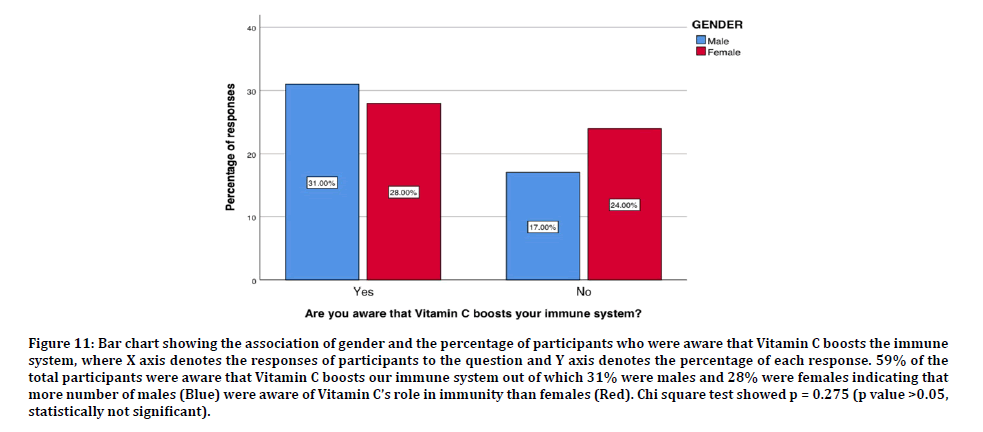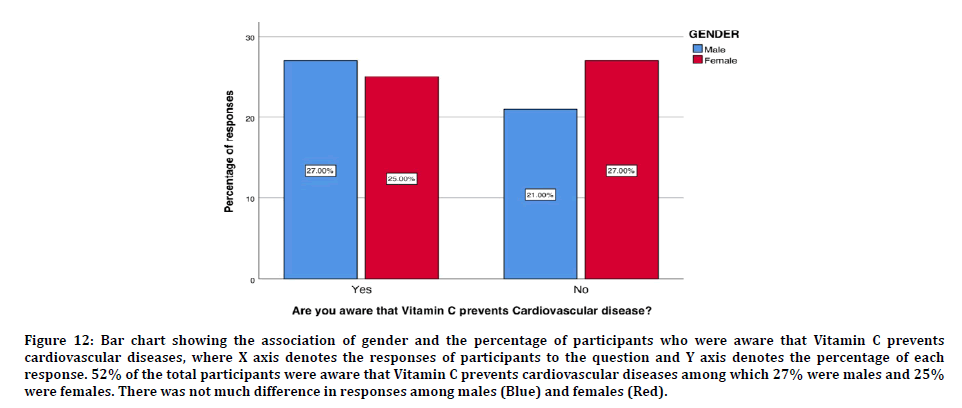Research - (2020) Advances in Dental Surgery
Awareness of Vitamin-C Rich Foods Among South Indian Population: A Survey
Jagadheeswari Ramamoorthy, Vishnu Priya V* and Gayathri R
*Correspondence: Vishnu Priya V, Department of Biochemistry, Saveetha Dental College and Hospitals, Saveetha Institute of Medical & Technical Sciences (SIMATS), Saveetha University Tamilnadu, Chennai, India, Email:
Abstract
Vitamin-C also known as Ascorbic acid is a water-soluble vitamin. Vitamin-C is needed for the growth and repair of tissues in all parts of your body. It can protect against gingivitis, the early stage of gum disease, and can prevent our teeth from loosening. People with adequate levels of Vitamin-C are considered to repel infections compared to people with Vitamin-C deficiency as it plays a major role in the immunity of an individual. It is therefore important to include plenty of Vitamin-C-containing foods in your daily diet. The aim of the study is to create awareness on Vitamin-C rich foods and its role in oral cavity among the South Indian population. This is a survey based study and was conducted on an online forum, Survey Planet. A questionnaire with 10 questions was circulated among South Indians. The responses and the demofigureic details of the participants were collected . The data was summarised as percentage using Excel and SPSS. The statistical tests used were Chi square tests and correlation analysis. p value <0.05 was considered statistically significant. From the study it is clear that 90% of them are aware of sources of Vitamin-C and only 78% of the population are aware of the health benefits of Vitamin-C. 37% of the participants were aware of the daily requirements of Vitamin-C. The study shows that only 24% of people have taken Vitamin-C supplements. 77% of them consume Vitamin- C foods once daily whereas 18% of them take twice daily. Only 57% of people are aware that deficiency of Vitamin-C causes Scurvy or bleeding gums. 52% of them are aware that Vitamin-C boosts our immunity and 52% of the population are aware that Vitamin-C prevents Cardiovascular disease. Awareness of Vitamin-C among males was slightly higher than that of females. Within the limits of the study we observed that awareness on Vitamin-C rich foods is present among the study population. Knowledge and awareness of Vitamin-C requirements and benefits is essential for a healthy living. As a Dental professional, providing patient education programs that stress the importance of good nutrition and selection of a well-balanced diet, are simple measures that will benefit the community.
Keywords
Vitamin-C, Scurvy, Immunity, Cardiovascular disease, Periodontitis, Survey planet
Introduction
Vitamin-C is an imperative supplement for wellbeing. It helps frame and look after bones, skin, and veins. It is found normally in certain nourishments, particularly in fruits and vegetables. Vitamin-C is otherwise known as Ascorbic acid [1]. It is a water-soluble vitamin and hence cannot be stored in the body and its daily intake is essential. Fresh fruits and vegetables are the best sources of Vitamin-C. Heating and cooking can destroy some of the Vitamin-C, so consumption of raw fruits are preferred [2].
Common citrus fruits such as lemon, orange, kiwi, guava, grapefruit, and vegetables such as broccoli, cauliflower and capsicums are rich, natural sources of Vitamin-C [3]. Other sources of Vitamin-C rich fruits include papaya, cantaloupe and strawberries [4]. Vitamin-C is needed for the expansion and repair of tissues altogether parts of your body. It also helps in repair and maintain cartilage, bones, and teeth and aids in the absorption of iron. Vitamin-C plays a major role in the production of collagen and certain neurotransmitters [3,5]. It helps to metabolise the proteins and its antioxidant activity reduces the risk of cancers. Collagen, which is the main component of connective tissue and the most abundant protein in mammals is produced with the help of Vitamin-C. Previous researches conducted in 1942 suggested that wounds took longer time to heal if someone had scurvy [6]. Scurvy results from the deficiency of Vitamin-C. The common symptoms of Scurvy include swollen joints, bleeding gums, mobile teeth, anaemia, and tiredness. Scurvy can rebound if a person takes very high doses of Vitamin-C and then discontinues it quickly [7].
Vitamin-C acts as an antioxidant and helps in repairing tissue and reducing damage due to inflammation and oxidation. People with adequate levels of Vitamin-C are thought to be better ready to repel infections compared to people with Vitamin-C deficiency. Vitamin-C can also help prevent acute respiratory infections, especially in people with malnutrition and people who are physically stressed [8]. Researchers have also found that Vitamin-C can kill drug-resistant tuberculosis (TB) bacteria during a laboratory culture. According to previous studies in 2013 adding Vitamin-C to TB drugs could shorten therapy. Vitamin-C may help in treating cancer. As an antioxidant, it protects the body against oxidative stress and helps prevent the oxidation of other molecules. It appears to regenerate other antioxidants in the body. Many people believe that Vitamin-C can cure a standard cold, but research has not confirmed this [9]. However, large doses of Vitamin-C may protect people that are exposed to severe physical activity and cold temperatures.
Adult males should consume 90 milligrams (mg) of Vitamin-C per day and females should consume 75 mg per day, according to the National Institutes of Health (NIH). During pregnancy, women should have 85 mg a day, and 120 mg while breastfeeding. Smokers have lower levels of Vitamin-C than nonsmokers, partly because they have higher levels of oxidative stress [10]. Smoking also causes inflammation and damage to the mucous membranes of the mouth, throat, and lungs. Vitamin-C is necessary for healthy mucosa and helps reduce inflammation, so the NIH recommends that smokers consume an extra 35 mg of Vitamin-C each day. The therapeutic effect of Vitamin-C was explored by Pauling .The therapeutic role of Vitamin-C studied by Pauling generated much controversy yet he was the first to introduce the concept of high doses of Vitamin-C for the treatment of various conditions from cold to cancer [11]. Since then mega doses of Vitamin-C are widely utilized in the treatment and prevention of an outsized number of disorders like diabetes, atherosclerosis, common cold, cataracts, glaucoma, macular degeneration, stroke, heart diseases, cancer and so on.
The role of Vitamin-C in maintaining the teeth and gingiva remains unchallenged. Clinical findings indicate that Vitamin-C is effective in improving the defence mechanisms of the host and is therefore implicated in preserving the periodontal health [12]. Gingival manifestations of Vitamin-C deficiency are the most severe when the oral hygiene is poor. The gingiva generally does not involve if the teeth are not erupted or if the patient is edentulous, although subepithelial haemorrhages can occur. The gingiva becomes hyperaemic with a tendency to bleed on interdental papilla where disintegration of marginal epithelium occurs [13]. Vitamin-C promotes periodontal health by maintenance of gingiva, periodontal ligament, cementum and alveolar bone. This is partly due to the essential role of Vitamin-C for the synthesis of collagen. In addition to the present role, Vitamin-C may lower the danger of periodontitis, and even facilitate healing of the periodontal tissues due to its strong antioxidant capacity [14].
The aim of this study is to create an awareness on Vitamin-C rich foods and its role in oral cavity among the South Indian population. Knowledge and awareness of Vitamin-C requirements and benefits is essential for a healthy living. As a Dentist, providing Patient education programs that stress the importance of good nutrition and selection of a well-balanced diet, are simple measures that will benefit the community.
Materials and Methods
The study was conducted in an online platform with a sample size of 100 participants belonging to the age group less than 60 years, who were predominantly South Indians. The study setting had certain advantages like flexibility in data collection and economical. A questionnaire containing 10 questions was prepared based on Vitamin-C and circulated among 100 participants through the online platform called Survey Planet, using a convenience sampling methodology. The demofigureic details and the responses of the participants were collected. The collected data was tabulated in Excel. The data from Excel was imported to SPSS for statistical analysis. The data was summarised as percentage and represented through bar Figures showing the percentage of each response. The statistical tests used were Chi square tests and correlation analysis. p value <0.05 was considered statistically significant. The results were finally interpreted in detail.
Results and Discussion
Participants belonging to the age group 10-60 years participated in the study. Majority of the participants belong to the age group of 10-20 years (31%) followed by 20-30 years (23%) (Figure 1). Among the total participants, the distribution of females (52%) was slightly higher than that of males (48%) (Figure 2). 90% of the total participants were aware of foods rich in Vitamin-C among which 44% were males and 46% were females (Figure 3). 78% of the participants were aware of the health benefits of Vitamin-C (Figure 4).
Figure 1: Bar chart showing the age distribution of the participants taken for the study where X axis denotes the age and Y axis denotes the percentage of participants. South Indians of age group 10-60 years participated in the study. Majority of the participants belonged to the age group of 10-20 years (31%) followed by 20-30 years (23%).
Figure 2: Bar chart showing the gender distribution of the participants taken for the study where X axis denotes the gender and Y axis denotes the percentage of distribution of Males (Blue) and Females (Red). Distribution of Females (52%) were slightly higher than that of Males (48%).
Figure 3: Bar chart showing the association of gender and the percentage of participants who were aware of Vitamin C rich foods, where X axis denotes the responses of participants to the question and Y axis denotes the percentage of each response. 90% of the total participants were aware of foods rich in Vitamin C among which 44% were males and 46% were females. There was not much difference in responses among males (Blue) and females (Red). Chi square test was done, and p value was found to be 0.594 (p value >0.05), statistically not significant.
Figure 4: Bar chart showing the association of gender and the percentage of participants who were aware of the health benefits of Vitamin C, where X axis denotes the responses of participants to the question and Y axis denotes the percentage of each response. 78% of the participants were aware of the health benefits of Vitamin C. There was not much difference in responses among males (Blue) and females (Red). Chi square test was done and p value was found to be 0.451 (p value >0.05), statistically not significant.
57% of the total participants were aware that Vitamin-C deficiency causes Scurvy or bleeding gums among which 30% were males and 27% were females (Figure 5). 77% of the participants consume Vitamin-C rich foods once daily, 18% of the participants consume twice daily and 5% of the participants consume thrice daily (Figure 6). 64% of the total participants were aware that Vitamin-C helps in wound healing among which 33% were males and 31% were females (Figure 7). 57% of the total participants consume enough Vitamin-C foods regularly among which 30% were males and 27% were females (Figure 8). 24% of the total participants had taken Vitamin-C supplements out of which 14% were males and 10% were females (Figure 9).
Figure 5: Bar chart showing the association of gender and the percentage of participants who were aware that deficiency of Vitamin C causes bleeding gums, where X axis denotes the responses of participants to the question and Y axis denotes the percentage of each response. 57% of the total participants were aware among which 30% were males and 27% were females indicating that a greater number of males (Blue) were aware of Vitamin C deficiency compared to females (Red). Chi square showed p=0.541 (p value>0.05, statistically not significant).
Figure 6: Bar chart showing the association of gender and the frequency of consumption of Vitamin C rich foods per day, where X axis denotes the responses of participants to the question and Y axis denotes the percentage of each response. 77%, 18%, and 5% of the participants consume Vitamin C rich foods once daily, twice daily and thrice daily respectively. There was not much difference in responses among males (Blue) and females (Red). Chi square test was done, and p value was found to be 0.871 (p value >0.05, statistically not significant).
Figure 7: Bar chart showing the association of gender and the percentage of participants who were aware that Vitamin C helps in wound healing, where X axis denotes the responses of participants to the question and Y axis denotes the percentage of each response. 64% of the total participants were aware that Vitamin C helps in wound healing among which 33% were males and 31% were females. There was not much difference in responses among males (Blue) and females (Red). Chi square test showed p= 0.342 (p value >0.05, statistically not significant).
Figure 8: Bar chart showing the association of gender and the percentage of participants who consume enough amount of Vitamin C rich foods regularly, where X axis denotes the responses of participants to the question and Y axis denotes the percentage of each response. 57% of the total participants consume enough Vitamin C foods regularly among which 30% were males and 27% were females indicating that males (Blue) consume Vitamin C foods regularly than females (Red). Chi square test showed p=0.286 (p value >0.05, statistically not significant).
Figure 9: Bar chart showing the association of gender and the percentage of participants who were under Vitamin C supplements, where X axis denotes the responses of participants to the question and Y axis denotes the percentage of each response. 24% of the total participants had taken Vitamin C supplements out of which 14% were males and 10% were females indicating that more number of males (Blue) have undergone Vitamin C supplementation than females (Red). Chi square test showed p=0.245 (p value >0.05, statistically not significant).
37% of the total participants were aware of the daily requirements of Vitamin-C among which 21% were males and 16% were females (Figure 10). 59% of the total participants were aware that Vitamin-C boosts our immune system out of which 31% were males and 28% were females (Figure 11). 52% of the total participants were aware that Vitamin-C prevents cardiovascular diseases among which 27% were males and 25% were females (Figure 12).
Figure 10: Bar chart showing the association of gender and the percentage of participants who were aware of the daily requirement of Vitamin C, where X axis denotes the responses of participants to the question and Y axis denotes the percentage of each response. 37% of the total participants were aware of the daily requirements of Vitamin C among which 21% were males and 16% were females indicating that a greater number of males (Blue) were aware of Vitamin C daily requirements than females (Red). Chi square test showed p=0.179 (p value >0.05, statistically not significant).
Figure 11: Bar chart showing the association of gender and the percentage of participants who were aware that Vitamin C boosts the immune system, where X axis denotes the responses of participants to the question and Y axis denotes the percentage of each response. 59% of the total participants were aware that Vitamin C boosts our immune system out of which 31% were males and 28% were females indicating that more number of males (Blue) were aware of Vitamin C’s role in immunity than females (Red). Chi square test showed p = 0.275 (p value >0.05, statistically not significant).
Figure 12: Bar chart showing the association of gender and the percentage of participants who were aware that Vitamin C prevents cardiovascular diseases, where X axis denotes the responses of participants to the question and Y axis denotes the percentage of each response. 52% of the total participants were aware that Vitamin C prevents cardiovascular diseases among which 27% were males and 25% were females. There was not much difference in responses among males (Blue) and females (Red).
Chi square test showed p=0.414 (p value>0.05, statistically not significant). From the study 90% of them are aware of sources of Vitamin-C such as fruits and vegetables among which 44% were males and 46% were females. There was not much difference in responses among males and females. Chi square test showed p=0.594 (p value >0.05, statistically not significant). Vitamin-C content in food is reduced by cooking, as well as during long periods of storage. Cooking losses may be lowered by steaming or microwaving. Consumption of raw fruits and vegetables in an adequate amount which corresponds to 5 or more servings of different fruits and vegetables a day, usually supplies all the Vitamin-C that is needed [14,15]. Among the total participants only 78% of the population are aware of the health benefits of Vitamin-C. Gender differences were not seen. Chi square test showed p=0.451 (p value>0.05, statistically not significant).
It plays an important role in bone formation, wound healing and the maintenance of healthy gingiva. It also has a major role in several metabolic functions. Only 57% of participants are aware that deficiency of Vitamin-C causes Scurvy or bleeding gums among which 30% were males and 27% were females indicating that a greater number of males were aware of Vitamin-C deficiency symptoms compared to females. Chi square test showed p=0.541 (p value >0.05, statistically not significant). Without Vitamin-C, the synthesised collagen fibres are unstable to perform its normal function and hence results in bleeding. Generally scurvy will manifest when the Vitamin-C reserve is reduced to 300 mg in a normal adult of 70 kg mass and a Vitamin-C reserve of 1500 mg [16]. Using different indicators for Periodontitis makes it difficult to compare the strength of associations between Vitamin-C and periodontal disease obtained from multiple studies, because of a lack of easily identifiable standards [17]. 77% of them consume Vitamin- C foods once daily, 18% of them take twice daily whereas only 5% of the participants take thrice daily. There was not much difference in responses among males and females. Chi square test showed p=0.871 (p value >0.05, statistically not significant). Vitamin-C has received a great deal of attention, and with good reason. Higher blood levels of Vitamin-C may be the ideal nutrition marker for overall health. 64% of the total participants were aware that Vitamin-C helps in wound healing among which 33% were males and 31% were females. There was not much difference in responses among males and females. Chi square test showed p=0.342 (p value >0.05, statistically not significant). 57% of the total participants consume enough Vitamin-C foods regularly among which 30% were males and 27% were females indicating that males consume Vitamin-C foods regularly than females. Chi square test showed p=0.286 (p value >0.05, statistically not significant). The study shows that only 24% of people have taken Vitamin-C supplements in the form of tablets or syrup out of which 14% were males and 10% were females indicating that more number of males have undergone Vitamin-C supplementation than females. Chi square test showed p=0.286 (p value >0.05, statistically not significant). Regular use of Chewable Vitamin-C tablets may lead to severe erosion of enamel of the teeth because of its acidity and abrasiveness [18]. Hence it should not be formulated and marketed without a buffering formulation. 37% of the total participants were aware of the daily requirements of Vitamin-C among which 21% were males and 16% were females indicating that a greater number of males were aware of Vitamin-C daily requirements than females. Chi square test showed p=0.179 (p value >0.05, statistically not significant). For adults, the recommended daily amount for Vitamin-C is 65 to 90 milligrams (mg) a day with a maximum of 2,000 mg a day. Approximately, fruit juice, an orange or a cup of strawberries, or broccoli provides enough Vitamin-C for the day for most of the people [19].
59% of them are aware that Vitamin-C boosts our immunity out of which 31% were males and 28% were females indicating that a greater number of males were aware of Vitamin-C’s role in immunity than females. Chi square test showed p=0.275 (p value >0.05, statistically not significant). Vitamin-C plays an important role in neutrophil functions such as increased chemotaxis, increased particulate ingestion and enhanced lysozyme-mediated non-oxidative killing. It also has an antibacterial effect, and it stimulates the natural killer (NK) cells [20]. 52% of the population are aware that Vitamin-C prevents Cardiovascular disease among which 27% were males and 25% were females. There was not much difference in responses among males and females. Chi square test showed p=0.414 (p value >0.05, statistically not significant). Previous research suggests that deficiency of Vitamin-C might be associated with a higher risk of mortality from Cardiovascular disease and Vitamin-C may slightly increase the endothelial function and lipid profiles in some groups with low plasma Vitamin-C levels [21]. The study is limited by a few factors such as small sample size and Geo Figure limitations. It is also a unicentric study with no external validity. A multicentric study can be done on the awareness of Vitamin-C rich foods among South Indian population A large study sample of people from different ethnicities is preferred for further studies. Longer duration of the study would give better results.
Conclusion
Within the limitations of the study, it is observed that awareness of Vitamin-C rich foods among the South Indian population is prevalent. Knowledge and awareness of Vitamin-C requirements and benefits is essential for a healthy living. As a Dental professional, providing Patient education programs that stress the importance of good nutrition and selection of a well-balanced diet, are simple measures that will benefit many. Further studies addressing the use of unified periodontal indicators and an elucidation of the implications of other factors should be performed to increase knowledge of the relationship between Vitamin-C and periodontal disease. Health education programs for patients that stress the importance of good nutrition and at the same time providing guidelines and practical information for the selection of a balanced diet, are simple measures that will benefit the community.
Acknowledgement
The authors thank Saveetha Dental College for extending full support to complete the study.
Conflict of Interest
Nil.
References
- Krinsky NI, Beecher GR, Burk RF, et al. Dietary reference intakes for Vitamin-C, Vitamin E, selenium, and carotenoids. Institute of Medicine. National Academies Press 2000.
- Zhou J, Chen C, Chen X, et al. Vitamin-C promotes apoptosis and cell cycle arrest in oral squamous cell carcinoma. Frontiers Oncol 2020; 10:976.
- Hossain R, Sarkar C, Islam MT. Ascorbic acid antagonizes the sedative effect of diazepam possibly through inhibition of GABA(Aρ₁) and GABA(B1) receptors. Cellular Mol Biol 2020; 66:15–19.
- Szarka A, Kapuy O, Lőrincz T, et al. Vitamin-C and cell death. Antioxidants Redox Signaling 2020.
- Packer L. Vitamin-C in health and disease. CRC Press 1997.
- Davies MB, Austin J, Partridge DA. Vitamin-C: Its chemistry and biochemistry. Royal Society of Chemistry 1991.
- Combs GF, McClung JP. The vitamins: Fundamental aspects in nutrition and health. Academic Press 2016.
- Rucker RB, Suttie JW, McCormick DB. Handbook of Vitamins. CRC Press 2001.
- Friedrich W. Vitamins. Walter de Gruyter 1998.
- Pelletier O. Cigarette smoking and Vitamin-C. Nutrition Today 1970; 12–15.
- Theodorou AA, Paschalis V, Kyparos A, et al. Passive smoking reduces and Vitamin-C increases exercise-induced oxidative stress: Does this make passive smoking an anti-oxidant and Vitamin-C a pro-oxidant stimulus?. Biochem Biophysical Res Communications 2014; 454:131–136.
- Carr AC, Lykkesfeldt J. Discrepancies in global vitamin-C recommendations: A review of RDA criteria and underlying health perspectives. Critical Reviews Food Sci Nutrition 2020; 454:1–14.
- https://www.readhowyouwant.com/
- Challem J. User’s guide to nutritional supplements. Basic Health Publications 2003.
- Koshio S. Critical review of the effects of ascorbic acid on fish behavior. Ascorbic Acid in Aquatic Organisms 2000; 241–253.
- Kern M, Gardner JM. Mucocutaneous manifestations of scurvy. New England J Med 2020; 382:e56.
- Touyz LZ. Oral scurvy and periodontal disease. J Canadian Dent Assoc 1997; 63:837–845.
- Clarke R, Armitage J. Vitamin supplements and cardiovascular risk: Review of the randomized trials of homocysteine lowering vitamin supplements. Seminars Thrombosis Hemostasis 2000; 26:341–348.
- Guiné RPF. Vitamin-C: Dietary sources, technology, daily requirements and symptoms of deficiency. Nova Science Pub Incorporated 2013.
- Abo-Al-Ela, HG. Does Vitamin-C mitigate the detrimental effect of androgens on immunity? Res Veterinary Sci 2019; 125:43–44.
- Frei B. Vitamin-C and cardiovascular disease: Mechanisms of action. Vitamin-C Springer 1998; 59–71.
Author Info
Jagadheeswari Ramamoorthy, Vishnu Priya V* and Gayathri R
Department of Biochemistry, Saveetha Dental College and Hospitals, Saveetha Institute of Medical & Technical Sciences (SIMATS), Saveetha University Tamilnadu, Chennai, IndiaCitation: Jagadheeswari Ramamoorthy, Vishnu Priya V, Gayathri R, Awareness of Vitamin-C Rich Foods Among South Indian Population: A Survey, J Res Med Dent Sci, 2020, 8 (7): 330-338.
Received: 16-Oct-2020 Accepted: 05-Nov-2020 Published: 12-Nov-2020

